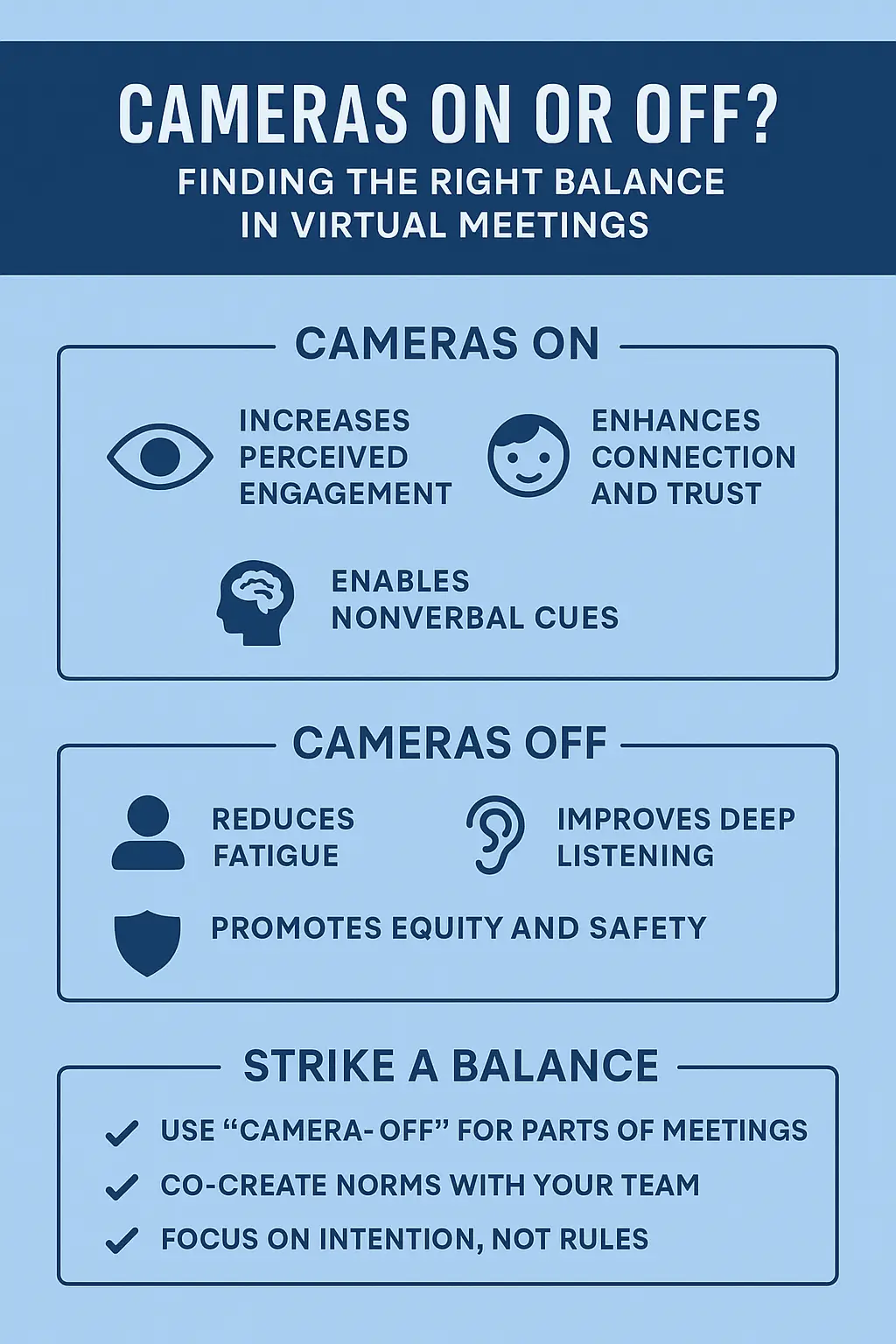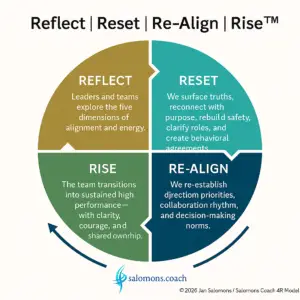Cameras On or Off? What Really Happens in Virtual Meetings — and Why It Matters for Listening, Energy, and Connection

A desktop study to conclude when en when not to use the camera in virtual meetings
I’ve often wondered why, in some virtual meetings, I listen better when the camera is off.
As a coach, I rely heavily on facial expressions, micro-reactions, and subtle energy shifts. These cues help me feel the person behind the words. Yet there are moments when I switch the camera off — and something surprising happens: I hear more deeply.
It’s counterintuitive. In a world that celebrates “visibility” and “engagement,” turning the camera off almost feels taboo. But recent research from leading institutions like Harvard Business Review, MIT Sloan, Stanford University, and Harvard Business School shows that this paradox might actually make sense.
So, I did a desktop study, using some AI’s (ChatGPT, Le Chat, Copilot) to perform a desktop study quickly and mix this with my personal experiences. I work in an international corporate (ASML) as well as in my own business, where I mainly coach one on one, and often virtually. I wanted to understand better what the role of the camera is in various situations.
The Hidden Cost of Being Always ‘On’
Harvard Business Review published a study titled “Research: Cameras On or Off?” which found that virtual meeting fatigue isn’t just caused by too many meetings — it’s strongly linked to having the camera on¹. The cognitive load of managing facial expressions, posture, and background, while maintaining a professional presence, significantly increases exhaustion.
MIT Sloan Management Review confirms this from a neurological perspective. Their article “Virtual Meetings and Your Brain” reports EEG and ECG evidence that video meetings create higher mental strain and sustained stress responses than in-person conversations².
Your brain is working harder to interpret flattened visual cues and delayed micro-signals, even though your eyes and ears think you’re just “talking on screen.”
It’s not just the quantity of meetings that drains us — it’s the constant performative awareness of being visible.
When Cameras Help — and When They Don’t
Of course, visibility has its benefits.
In small groups or coaching settings, eye contact and facial expression strengthen trust, empathy, and rapport. Harvard Business School research on virtual teams shows that visual connection helps build psychological safety and shared understanding³ — both essential in coaching and leadership development.
But context matters.
When meetings are informational, operational, or cognitively heavy, cameras can actually hinder deep listening. MIT’s cognitive research suggests that people absorb information more accurately and reflectively when the visual channel is simplified, freeing mental bandwidth for meaning rather than self-presentation⁴.
In other words:
Sometimes turning the camera off allows the brain — and the person — to truly listen.
One-on-One vs. Group Meetings: It’s Not the Same Brainwork
Emerging research from Stanford University and Harvard Business Review reveals that virtual meeting fatigue isn’t uniform — it depends heavily on the number of participants and the social context.
In 1-on-1 settings, cameras foster genuine connection. The Stanford Virtual Human Interaction Lab (Jeremy Bailenson, 2021) found that small, dyadic video calls enable eye-gaze coordination and empathy synchronization, supporting deeper trust and mutual regulation⁵. These conversations mirror face-to-face communication and are ideal for coaching, mentoring, or feedback sessions.
But in multi-participant meetings, the same visual connection becomes a source of overload. The brain attempts to monitor and interpret multiple faces simultaneously, each perceived as being in close personal space — something it was never designed to do. The result: cognitive fatigue, divided attention, and emotional depletion.
Harvard Business Review adds that people in group meetings experience higher self-presentation anxiety and a stronger sense of being watched⁶. This effect is intensified in hierarchical or mixed-status meetings — for example, when direct reports are on screen with senior leaders. The presence of many cameras magnifies social comparison, hierarchy awareness, and impression management.
MIT Sloan’s findings reinforce this: multi-person video meetings demand constant decision-making about where to direct attention and when to speak, which disrupts listening depth and empathy accuracy⁷.
In contrast, one-on-one settings allow participants to focus fully on meaning, tone, and emotion — the core ingredients of real connection.
The implication is clear:
Virtual presence does not scale linearly. What builds trust and connection in a one-on-one conversation can drain energy and attention in a large group.
The Equity Dimension: Not Everyone Feels Safe Being Seen
There’s also a human-equity angle. Research from the University of Arizona, cited in HBR, shows that women and junior employees report higher fatigue and pressure to appear presentable on video⁸.
When organizations enforce “camera-on” policies, they may unintentionally increase stress and self-consciousness, especially for those balancing home contexts, caregiving, or cultural discomfort with constant visibility.
As coaches and leaders, we must remember: psychological safety includes the freedom to choose visibility.
Beyond Fatigue: How the Camera Shapes Connection
Harvard’s research also reveals that camera presence changes how others perceive you. Participants with cameras off were often seen as less engaged or less leadership-ready, even when their contributions were equal⁹. Visibility signals presence, and absence risks misinterpretation.
So, turning the camera off can deepen your listening, but it may also reduce your perceived influence in the virtual room.
The paradox is clear:
Camera on — higher connection, but higher fatigue.
Camera off — lower stress, but potential loss of visibility.
So what’s the way forward?
Intentional Use of Cameras: A New Virtual Etiquette
From my experience coaching leaders and teams worldwide, the solution isn’t about rules — it’s about intention.
Here’s how I apply it:
- Co-create norms at the start of meetings. Define when visibility adds value (dialogue, emotion, trust-building) and when it’s okay to switch off (deep listening, reflection, note-taking).
- Encourage people to turn off self-view, even when their camera is on. MIT research shows this drastically reduces fatigue and self-consciousness¹⁰.
- Design “camera-off” listening blocks in coaching or team sessions — for instance, 5 minutes of pure listening before anyone speaks.
- Focus on quality of attention, not image. What matters is presence of mind, not pixels on screen.
For Coaches: Using Both Modalities with Purpose
In my own coaching sessions, I’ve learned that both modalities have their moments.
When I’m helping a leader navigate emotion, uncertainty, or relational complexity, I keep the camera on — it allows empathy and resonance.
When the conversation becomes deeply reflective, I often invite them to switch it off and close their eyes:
“Let’s listen to what’s happening inside.”
It changes the energy completely.
Without visual cues, people slow down, tune inward, and listen to themselves more honestly.
This isn’t disengagement.
It’s presence — of a different kind.
Leadership in a VUCA World: Seeing and Hearing Differently
In a world where volatility, uncertainty, complexity, and ambiguity are the new normal, leaders must learn to manage both energy and attention. Constant visibility drains both.
High-performance teams are not built by being always “on,” but by knowing when to connect visually and when to create space for deep, undistracted listening.
That balance — between visibility and presence — is part of what I call Reflect → Reset → Align → Rise.
It’s not only about how we show up in meetings, but how we create conditions for awareness, energy, and genuine human connection.
References
- Harvard Business Review (2021). Research: Cameras On or Off? https://hbr.org/2021/10/research-cameras-on-or-off
- MIT Sloan Management Review (2021). Virtual Meetings and Your Brain: Four Ways to Refresh. https://sloanreview.mit.edu/article/virtual-meetings-and-your-brain-four-ways-to-refresh
- Harvard Business School Working Knowledge (2023). The Critical Minutes After a Virtual Meeting That Can Build or Break Teams. https://www.library.hbs.edu/working-knowledge/virtual-meetings-can-ruin-teams-what-leaders-do-afterward-can-make-them-better
- MIT Media Lab (2022). The Shortcomings of Video Conferencing Technology. https://direct.mit.edu/pvar/article-pdf/doi/10.1162/pres_a_00398/2191842/pres_a_00398.pdf
- Bailenson, J. (2021). Nonverbal Overload: A Theoretical Argument for the Causes of Zoom Fatigue. Technology, Mind, and Behavior. https://doi.org/10.1037/tmb0000030
- Shockley, K. et al. (2021). The Fatigue of Camera Use in Virtual Meetings. University of Arizona / HBR Summary.
- MIT Sloan Management Review (2022). Virtual Meetings and Your Brain. https://sloanreview.mit.edu/article/virtual-meetings-and-your-brain-four-ways-to-refresh
- University of Arizona (2021). Camera Use and Gendered Fatigue in Virtual Meetings. https://arizona.edu
- HBR (2022). Perceptions of Engagement in Virtual Teams. https://hbr.org
- Stanford Virtual Human Interaction Lab (2021). Zoom Fatigue and the Role of Self-View. https://vhil.stanford.edu




